Motivation
Plume expansion is important for Pulsed laser deposition
(PLD) and nanoclusters formation.
In vacuum - self-similar
adiabatic expansion with radius Rµ
t.
Higher ambient pressures
- strong explosion type model with Rµ
t2/5.
Later stage - plume
stops, external SW detaches ® weak SW ®
sound wave. Low energy - no strong SW region.
Goals:
Unified analytical approach. Analytical formulas,
for transitional stages. Describe plume edge heating and plume splitting.
Model schematic.
Central part of the plume
- free expansion laws.
Densities and pressures
in the internal and external SWs - constant.
Densities ri,
re
- from corresponding SW conditions.
Pressure = pressure pc
at the contact boundary - obeys Newton's
law for the external SW.
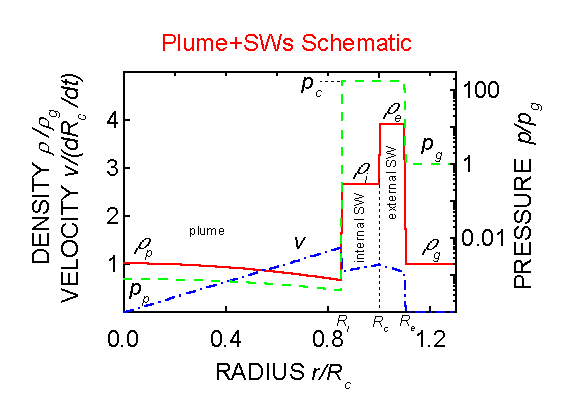
Equations.
Simplified description = conservation
laws + assumptions about the profiles of variables.
This results in the equations for four dynamic variables
Ri,
Rc, Re, R.
Key approximation: densities
and pressures in both SWs do not depend on r.
Central part of the plume
is
unaffected by the ambient gas. It "does not know" about the ambient Þ
behaves
like free plume.
Internal SW: density
- from strong SW
condition. Mass conservation within the plume
defines position Ri.

External SW.
density - from general SW
condition.
Mass conservation in the external
SW yields differential equation for Re.

Expansion dynamics
obeys energy conservation.

One can consider this as a differential
equation for Rc.
Thermal energies
Eit and Eet - from the pressure
at the contact surface, pc.
pc
-
from the Newton's law (balance of forces) for
the external SW:

Momentum of the external
SW Pe must be estimated as well
"Master" equation (qualitative)
Homogeneous plume (no internal
SW), strong external SW near contact surface Þ
Simplified
expressions for energies and
pressure
in the Newton's law Þ

Maf
-
initial Mach number with respect to ambient. Coefficients
x
A,
x
B,
x
c
~1.
Free expansion-strong SW and
stopping distance and time can be estimated from here.
Below density (red line),
pressure
(logarithmic scale, green line),
velocity
profile (blue line) are shown. Spatial scale
is normalized to the contact boundary position, and pressure and density
to those of the ambient gas. This animation illustrates the following
sequence of events (within the frame of a simplified model).
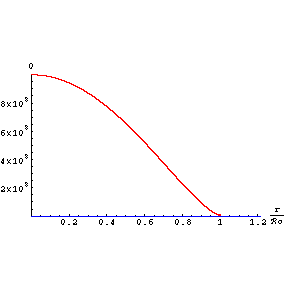
Inertial expansion slows down due to snowplowing
of ambient gas in external SW. Simultaneously internal SW is formed. Initially
it is near the contact surface and all energy is in the kinetic
energy of the plume. With Me~M internalSW
moves inwards and reaches the center; it possesses noticeable amount of
kinetic energy. Then, homogeneous
plume is characterized by Eik and Eit.
Kinetic and thermal energy of external SW build up; Rc and
Re
propagate together according to point blast law. Thermal
energy is within the plume, kinetic
energy is within the external SW
as Me>>M. This stage is non-adiabatic.
With strong external SW all energies are almost constant. The width of
SW
region depends on vf/cg. Even for rather
high initial velocity vf, finite pressure of ambient
gas soon results in the stopping of the plume, accompanied by its additional
heating. External SW detaches from the contact surface and becomes sound
wave (Re approaches slope 1 in Fig. 2). Here Eek
decreases, Eet increases.
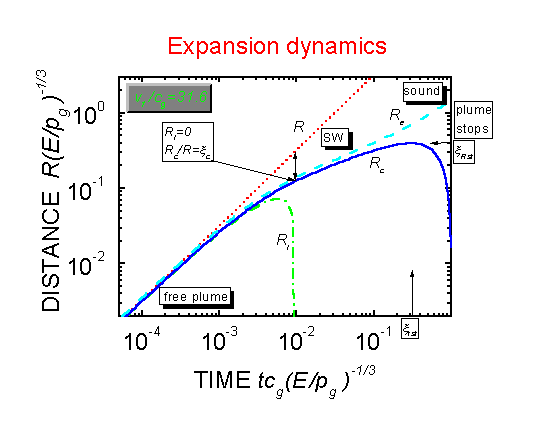
Fig. 2 Free plume R - dotted line, Internal
SW Ri - dash-dotted line, contact boundary Rc
-
solid line, external SW Re - dashed line.
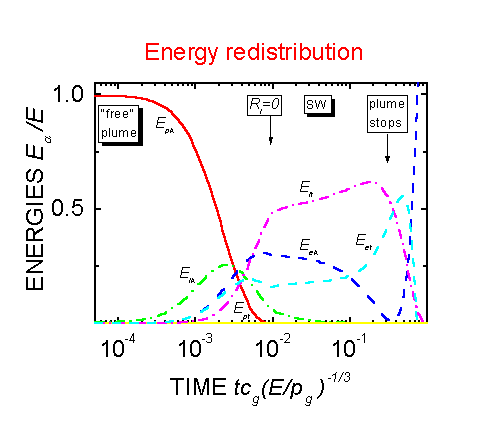
Fig. 3 Redistribution
of kinetic and thermal energies (indexes k and t)
between the plume and external SW. Energies are normalized to initial energy
E.
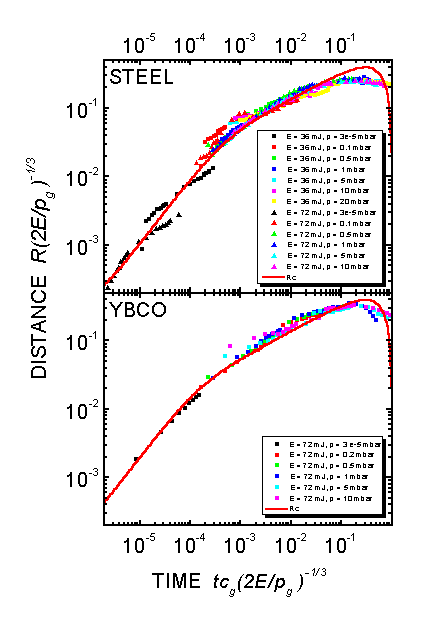
Fig. 4 Experimental data
for Steel and YBCO (Ar, KrF laser) in dimensionless variables measured
by ICCD camera.
Home






